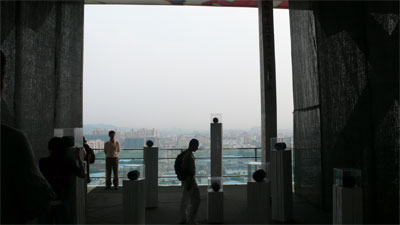
Over the next three days, Claire Louise Staunton, current resident curator at the OCT Contemporary Art Terminal in Shenzhen, China, will file reports from this year's Guangzhou Triennial, Shanghai Bienniale, and Nanjing Triennial. - Ceci Moss
The first stop on my journey is Guangzhou in the southwest of China, a humid and densely populated city with a liberal reputation. On the day of my visit to the Third Guangzhou Triennial, torrential rain poured down, which had a comically disastrous effect on the proceedings. Invitees were trapped and latecomers barred from the location for the exhibition's opening comments, Alain Fouraux and Rem Koolhaas' Times Museum, a rather utopian project proposed at the 2005's triennial that housed a small part of the larger exhibition. The rising flood and the downpour threatened curator Sarat Maharaj and his team with electrocution as they attempted to bid 'Farewell to Post-Colonialism' on the short-circuited PA system.
Sadly California-based artist Simon Leung's video piece on the ground floor was rained out, but after waiting 30 minutes to get into the only elevator, the 14th floor served as a life boat with video work The Rock Point Inn from Huang Xiaopeng. The piece interrogates the self-colonialization of contemporary China through his subtly manipulated depiction of Thames Town, an exact replica of Lyme Regis, UK. In the adjacent room was Wang Jiahao's F1City:REeAL TV a video game using real-life footage which presented itself as a commentary on the growth of Formula One racing in the third world.
I ascended the theoretical and actual quagmire of the top floor where the rain poured dangerously close to the numerous sound and video installations from German artist Marc Behrens, the Chinese collective Sound Unit (Zhang Anding, Zhong Minjie, Lin Zhiying), and paintings installed by Duan Jianyu, who all shared the same geographical focus on Qinghai province. Gabriel Acevedo Velarde performed his Marathon in the space by dancing alongside an installation of his daily youtube uploads. Several other sound and video installations competed with the damp hordes and the pelting rain so I squeezed into the elevator once more and made my way to the main exhibition site in the Guangdong Art Museum.
The Third Guangzhou Triennial was huge. Not in terms of size, but there were enough artworks and artists in this show to fill three times the space. The pieces crowded each other at times and the claustrophobia was immediately apparent in the entrance of the main show. Fighting for its own space behind a large tent installation by Liu Dahong was Christian Jankowski's incredible China Painters. The piece is an installation of commissioned paintings and video interviews made with copyist painters in Dafen, China that has now travelled to New York, Switzerland and, in this exhibition, returned back to the same province where it began.

Such a jam-packed show is no surprise considering the number of curators involved and the complex curatorial remit of presenting the notion of post-post-colonialism. Maharaj leads a team of major curators with three principal categories, Projects in Progress, Thinking Room and Free Radicals as well as research curators who presented six independent projects. Much of this categorization became lost but notable gems amongst the confused excitement included Uriel Orlow's Benin Project -- a multi-screen video and etching installation about the looted Benin Bronzes now on display in European museums. Cuban artist Carlos Garaicoa Manso's Personal Library and video installation analysed the ubiquity of 'star-chitect's in China and Havana's own Chinatown. Tozer Pak presented documentation of his own kind of institutional critique with New York Public Library Project, where the artist intervened by folding the 22nd page of every book. Research curators Steven Lam and Tamar Guimaraes brought together a number of Whitney ISP artists and presented Mornings in Mexico, a beautiful series of artist's books and sound projects, using D.H. Lawrence's story of the same name. I found a moment to breathe surrounded by Felipe Mujica's hanging black fabric sculpture No State and was sent spinning again by Wu Shanzhuan's Yellow Flight, an epic work that exists as an international plane journey from airport to airport with no definitive arrival nor departure made manifest through a real smoking section and a mock arrival gate. Joseph DeLappe's Gandhi's Salt March to Dandi in Second Life is an appropriate end to my experience of the triennial, the immersive multimedia installation reminded of the long journey to Shanghai and Nanjing ahead.


After leaving the space, I navigated my way through a Guangzhou vegetable market, hopped over the flood waters and visited the Vitamin Creative Space, a physical gallery space for the experiments of an organisation that develops international projects with contemporary Chinese artists. In the space, I found the solo project Keywords School from Xu Tan that offers courses exclusively teaching the meanings of 125 Chinese key words, collected arbitrarily by the artist.
And before flying off to Shanghai, I managed to stop in at the brand new art space Ping Pong with its strategically timed opening of 'Cantocore Import', a dialogue through art practice with another space in San Francisco. This former car garage hosted, among others, multi-screen video installation News Reenactment which depicted social irregularities in daily life from Deer Fang and Jon Phillip's LED sculpture Special Economic Zone (Artonomics #11) which calculates live data from the Shenzhen stock markets.

